MERCEDES-BENZ S-CLASS CABRIOLET 2018 Owner's Manual
Manufacturer: MERCEDES-BENZ, Model Year: 2018, Model line: S-CLASS CABRIOLET, Model: MERCEDES-BENZ S-CLASS CABRIOLET 2018Pages: 502, PDF Size: 6.27 MB
Page 201 of 502
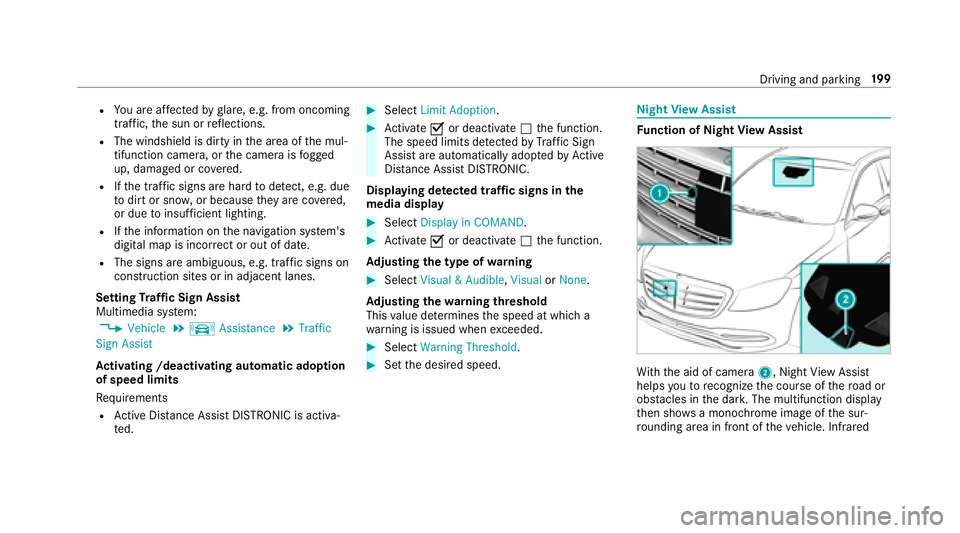
RYou are af fected byglare, e.g. from oncoming
traf fic, the sun or reflections.
RThe windshield is dirty in the area of the mul‐
tifunction camera, or the camera is fogged
up, damaged or co vered.
RIfth e traf fic signs are hard todetect, e.g. due
to dirt or sno w,or because they are co vered,
or due toinsuf ficient lighting.
RIf th e information on the navigation sy stem's
digital map is incor rect or out of date .
RThe signs are ambiguous, e.g. traf fic signs on
construction sites or in adjacent lanes.
Setting Traf fic Sign Assist
Multimedia sy stem:
,Vehicle.k Assistance.Traffic
Sign Assist
Ac tivating /deacti vating automatic adoption
of speed limits
Re quirements
RAc tive Dis tance Assist DISTRONIC is acti va‐
te d.
#Select Limit Adoption .
#Activate Oor deacti vate ª the function.
The speed limits de tected byTraf fic Sign
Assist are automatically adop tedby Active
Dis tance Assist DISTRONIC.
Displ aying de tected traf fic signs in the
media display
#Select Display in COMAND.
#Activate Oor deacti vate ª the function.
Ad justing the type of warning
#Select Visual & Audible ,Visual orNone.
Ad justing the warning threshold
This value de term ines the speed at which a
wa rning is issued when exceeded.
#Select Warning Threshold.
#Setthe desired speed.
Night View Assist
Function of Night View Assist
With th e aid of camera 2, NightView Assist
helps youto recognize the course of thero ad or
obs tacles in the dar k.The multifunction display
th en sho wsa monochrome image of the sur‐
ro unding area infront of theve hicle. Infrared
Driving and parking 19
9
Page 202 of 502
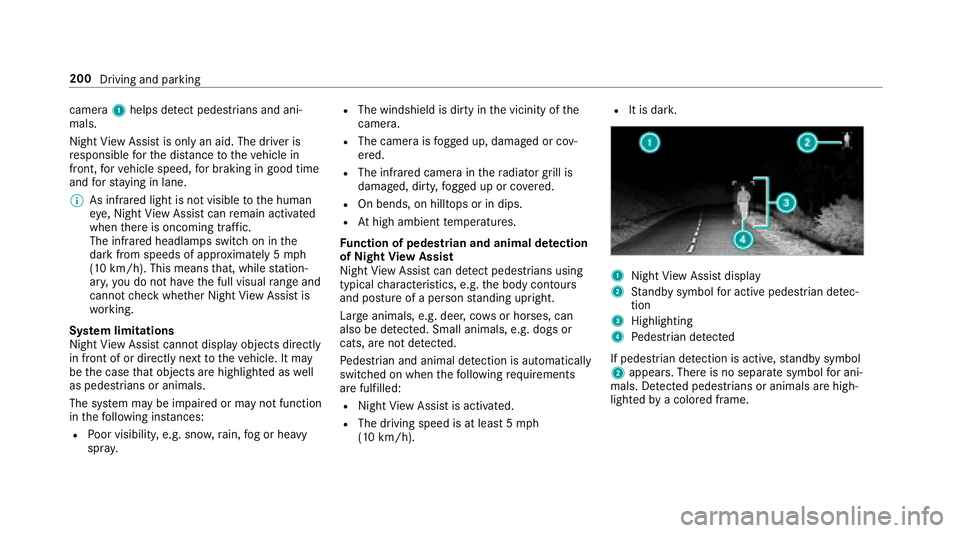
camera1 helps de tect pedestrians and ani‐
mals.
Night View Assist is only an aid. The driver is
re sponsible forth e dis tance totheve hicle in
front, forve hicle speed, for braking in good time
and forst ay ing in lane.
% As inf rare d light is not visible tothe human
ey e, Night View Assist canremain activated
when there is oncoming traf fic.
The infrared headlamps switch on in the
dark from speeds of appr oximately 5 mph
(10 km/h). This means that, while station‐
ar y, yo udo not ha vethe full visual range and
cannot check whe ther Night View Assist is
wo rking.
Sy stem limitations
Night View Assist cannot displ ayobjects directly
in front of or directly next totheve hicle. It may
be the case that objects are highlighted as well
as pedestrians or animals.
The sy stem may be impaired or may not function
in thefo llowing ins tances:
RPo or visibility, e.g. sno w,rain, fog or heavy
spr ay.
RThe windshield is dirty in the vicinity of the
came ra.
RThe camera is fogged up, damaged or cov‐
ered.
RThe infrared camera in thera diator grill is
damaged, dirty, fogged up or co vered.
ROn bends, on hilltops or in dips.
RAt high ambient temp eratures.
Fu nction of pedestrian and animal de tection
of Night View Assist
Night View Assist can de tect ped estri
ans using
typical characteristics, e.g. the body conto urs
and posture of a person standing upright.
Lar geanimals, e.g. deer, co wsor horses, can
also be de tected. Small animals, e.g. dogs or
cats, are not de tected.
Pe destrian and animal de tection is au tomatical ly
switched on when thefo llowing requ irements
are fulfilled:
RNight View Assist is activated.
RThe driving speed is at least 5 mph
(10 km/h).
RIt is dar k.
1NightView Assist display
2Standby symbol for active pedest rian de tec‐
tion
3Highlighting
4Pe destrian de tected
If pedestrian de tection is acti ve,st andby symbol
2 appears. There is no separate symbol for ani‐
mals. De tected pedestrians or animals are high‐
lighted bya colored frame.
200
Driving and parking
Page 203 of 502
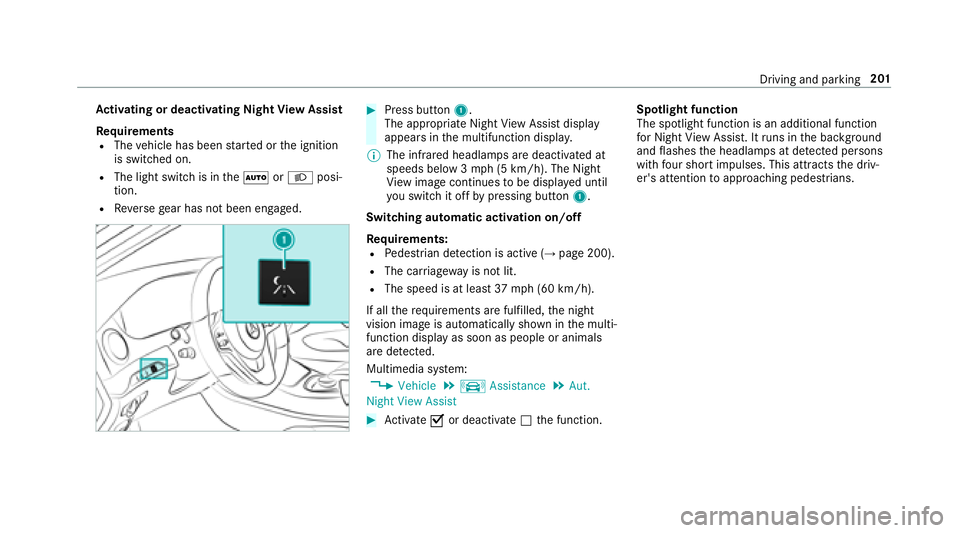
Activating or deactivating Night View Assist
Re quirements
RThe vehicle has been star ted or the ignition
is switched on.
RThe light switch is in theà orL posi‐
tion.
RRe versege ar has not been engaged.
#Press button 1.
The appropriate Night View Assist display
appears in the multifunction displa y.
% The infrared headlamps are deactivated at
speeds below 3 mph(5 km/h). The Night
Vi ew image continues tobe displa yed until
yo uswit chit off bypressing button 1.
Switching automatic activation on/off
Re quirements:
RPedestrian de tection is acti ve(→page 200).
RThe car riag ew ay is not lit.
RThe speed is at least 37mph (60 km/h).
If all therequ irements are fulfilled, the night
vision image is automatically shown in the multi‐
function display as soon as people or animals
are de tected.
Multimedia sy stem:
,Vehicle.k Assistance.Aut.
Night View Assist
#Ac tivate Oor deacti vate ª the function. Spotlight function
The spotlight function is an additional function
fo
r Night View Assist . Itruns in the bac kground
and flashes the headlamps at de tected persons
wi th four short impulses. This att racts the driv‐
er's attention toapproaching pedestrians.
Driving and parking 201
Page 204 of 502
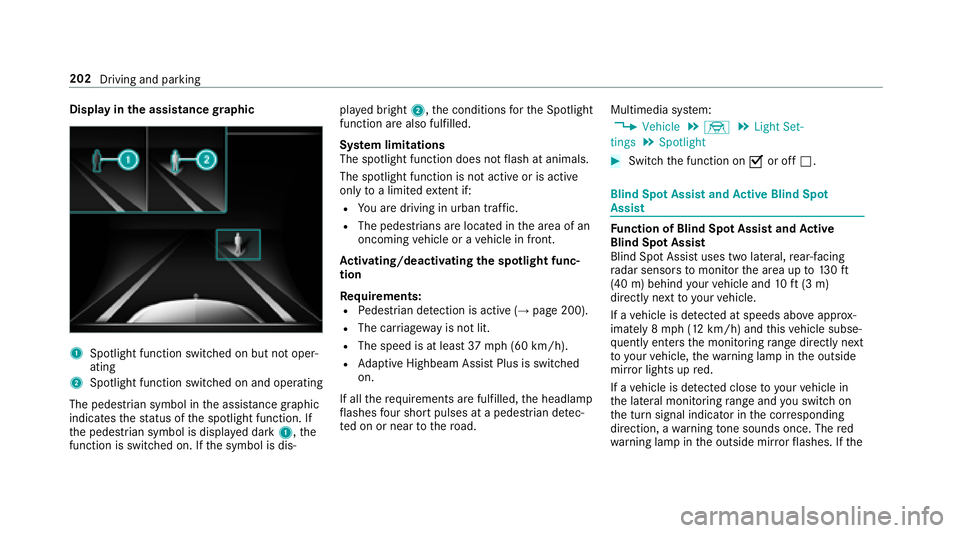
Displayin the assistance graphic
1Spotlight function switched on but not oper‐
ating
2Spotlight function switched on and operating
The pedestrian symbol in the assis tance graphic
indica testh est atus of the spotlight function. If
th e pedestrian symbol is displa yed dark 1,the
function is switched on. If the symbol is dis‐ pla
yed bright 2,the conditions forth e Spotlight
function are also fulfilled.
Sy stem limitations
The spotlight function does not flash at animals.
The spotlight function is not active or is active
only toa limited extent if:
RYo u are driving in urban traf fic.
RThe pedestrians are loca ted in the area of an
oncoming vehicle or a vehicle in front.
Ac tivating/deactivating the spotlight func‐
tion
Re quirements:
RPedestrian de tection is acti ve(→page 200).
RThe car riag ewa yis no tlit .
RThe speed is at leas t37 mph(6 0 km/h).
RAd aptive Highbeam Assist Plus is switch ed
on.
If all there qu irements are fulfilled, the headlamp
fl ashes four short pulses at a pedestrian de tec‐
te d on or near tothero ad. Multimedia sy
stem:
,Vehicle.÷.Light Set-
tings.Spotlight
#Switch the function on Oor off ª.
Blind Spot Assist and Active Blind Spot
Assi st
Function of Blind Spot Assist and Active
Blind Spot Assi st
Blind Spot Assist uses two lateral,rear-facing
ra dar sensors tomonitor the area up to130ft
(40 m) behind your vehicle and 10ft(3 m)
directly next to yourvehicle.
If a vehicle is de tected at speeds ab ove appr ox‐
imately 8 mph (12 km/h) and this vehicle subse‐
qu ent lyenters the monitoring range di rectly next
to yo urvehicle, thewa rning lamp in the outside
mir ror lights up red.
If a vehicle is de tected close to yourvehicle in
th e lateral monitoring range and youswit chon
th e turn signal indicator in the cor responding
direction, a warning tone sounds once. The red
wa rning lamp in the outside mir rorflashes. If the
202
Driving and parking
Page 205 of 502
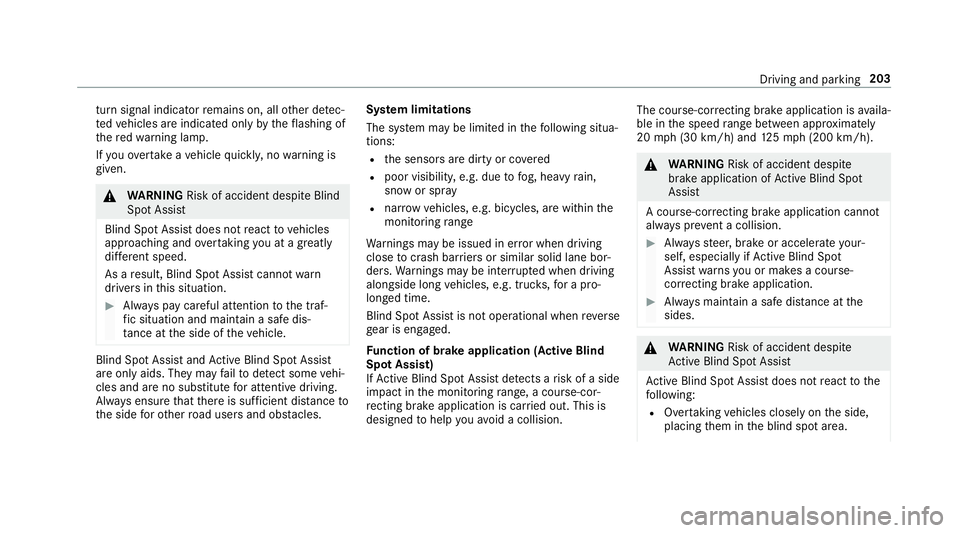
turn signal indicatorre mains on, all other de tec‐
te dve hicles are indicated only bytheflashing of
th ere dwa rning lamp.
If yo uove rtake a vehicle quickl y,no warning is
given.
& WARNING Risk of accident despite Blind
Spot Assist
Blind Spot Assist does notreact tovehicles
approaching and overtaking you at a greatly
di fferent speed.
As a result, Blind Spot Assist cannot warn
drivers in this situation.
#Alw ays pay careful attention tothe traf‐
fi c situation and maintain a safe dis‐
ta nce at the side of theve hicle.
Blind Spot Assist and Active Blind Spot Assi st
are only aids. They may failto detect some vehi‐
cles and are no substitute for attentive driving.
Alw ays ensure that there is suf ficient dist anceto
th e side forot her road users and obs tacles. Sy
stem limitations
The sy stem may be limited in thefo llowing situa‐
tions:
Rth e sensors are dirty or co vered
Rpoor visibility, e.g. due tofog, heavy rain,
snow or spr ay
Rnarrow vehicles, e.g. bicycles, are within the
monitoring range
Wa rnings may be issued in er ror when driving
close tocrash barr iers or similar solid lane bor‐
ders. Warnings may be inter rupte d when driving
alongside long vehicles, e.g. truc ks,fo r a pro‐
longed time.
Blind Spot Assist is not operational when reve rse
ge ar is engaged.
Fu nction of brake application (Active Blind
Spot Assist)
If Ac tive Blind Spot Assi stdetects a risk of a side
impact in the monitoring range, a cours e-cor‐
re cting brake application is car ried out. This is
designed tohelp youav oid a collision. The course-cor
recting brake application is availa‐
ble in the speed range between appr oximately
20 mph (30 km/h) and 125mp h (200 km/h).
&
WARNING Risk of accident despite
brake application of Active Blind Spot
Assi st
A cours e-correcting brake application cannot
alw ays pr event a collision.
#Alw aysst eer, brake or accelera teyour‐
self, especially if Active Blind Spot
Assi stwa rnsyo u or makes a course-
co rrecting brake application.
#Alw ays maintain a safe dis tance at the
sides.
& WARNING Risk of accident despite
Ac tive Blind Spot Assi st
Ac tive Blind Spot Assi stdoes not react tothe
fo llowing:
ROver taking vehicles closely on the side,
placing them in the blind spot area.
Driving and parking 203
Page 206 of 502
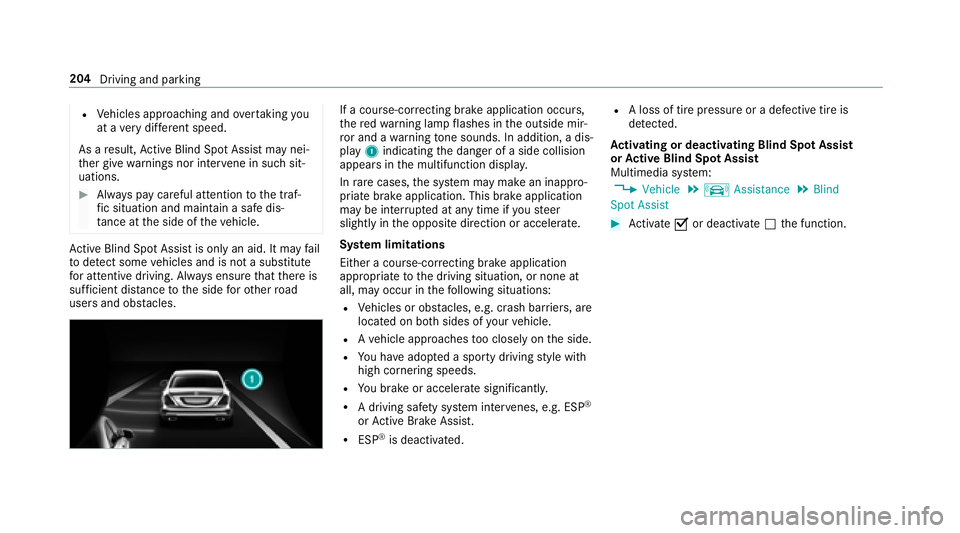
RVehicles approaching and overtaking you
at a very differe nt speed.
As a result, Active Blind Spot Assi stmay nei‐
th er give warnings nor inter vene in such sit‐
uations.
#Alw ays pay careful attention tothe traf‐
fi c situation and maintain a safe dis‐
ta nce at the side of theve hicle.
Ac tive Blind Spot Assi stis only an aid. It may fail
to detect some vehicles and is not a substitute
fo r attentive driving. Alw ays ensure that there is
suf ficient dist ancetothe side forot her road
users and obs tacles.
If a cours e-correcting brake application occurs,
th ere dwa rning lamp flashes in the outside mir‐
ro r and a warning tone sounds. In addition, a dis‐
pl ay 1 indicating the danger of a side collision
appears in the multifunction displa y.
In rare cases, the sy stem may make an inappro‐
priate brake application. This brake application
may be inter rupte d at any time if yousteer
slightly in the opposite direction or accelera te.
Sy stem limitations
Either a course-cor recting brake application
appropria teto the driving situation, or none at
all, may occur in thefo llowing situations:
RVe hicles or obs tacles, e.g. crash barr iers, are
located on bo thsides of your vehicle.
RAve hicle approaches too closely on the side.
RYo u ha veadop ted a sporty driving style with
high cornering speeds.
RYo ubr ake or accelerate signif icantly.
RA driving safe ty system inter venes, e.g. ESP®
or Active Brake Assi st.
RESP®is deacti vated.
RA loss of tire pressure or a defective tire is
de tected.
Ac tivating or deactivating Blind Spot Assi st
or Active Blind Spot Assi st
Multimedia sy stem:
,Vehicle.k Assistance.Blind
Spot Assist
#Ac tivate Oor deacti vate ª the function.
204
Driving and parking
Page 207 of 502
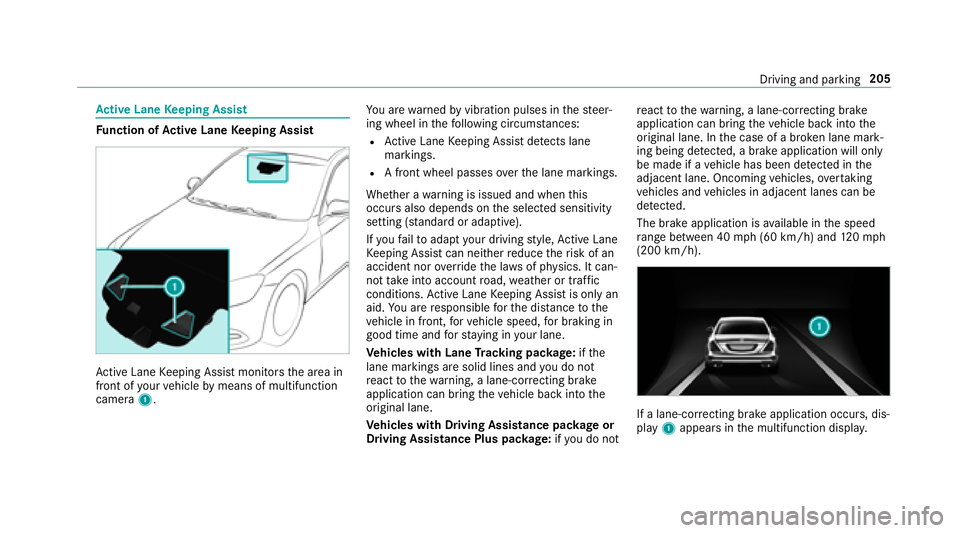
Active Lane Keeping Assist
Function of Active Lane Keeping Assist
Active Lane Keeping Assist monitors the area in
front of your vehicle bymeans of multifunction
camera 1. Yo
u are warned byvibration pulses in thesteer‐
ing wheel in thefo llowing circums tances:
RAc tive Lane Keeping Assist de tects lane
markings.
RA front wheel passes over the lane markings.
Whe ther a warning is issued and when this
occurs also depends on the selected sensitivity
setting (s tanda rdor adaptive).
If yo ufa ilto adapt your dr ivingst yle, Ac tive Lane
Ke eping Assist can neither reduce therisk of an
accident nor override the la wsof ph ysics. It can‐
not take into account road, weather or traf fic
conditions. Active Lane Keeping Assist is only an
aid. You are responsible forth e dis tance tothe
ve hicle in front, forve hicle speed, for braking in
good time and forst ay ing in your lane.
Ve hicles with Lane Tracking pac kage:if th e
lane markings are solid lines and you do not
re act tothewa rning, a lane-cor recting brake
application can bring theve hicle back into the
original lane.
Ve hicles with Driving Assistance pac kage or
Driving Assistance Plus pa ckage: ifyo u do not re
act tothewa rning, a lane-cor recting brake
application can bring theve hicle back into the
original lane. In the case of a broken lan
e mark‐
ing being de tected, a brake application will only
be made if a vehicle has been de tected in the
adjacent lane. Oncoming vehicles, overtaking
ve hicles and vehicles in adjacent lanes can be
de tected.
The brake application is available in the speed
ra nge between 40 mph (60 km/h) and 120mp h
(200 km/h).
If a lane-cor recting brake application occurs , dis‐
play 1appears in the multifunction displa y.
Driving and parking 205
Page 208 of 502
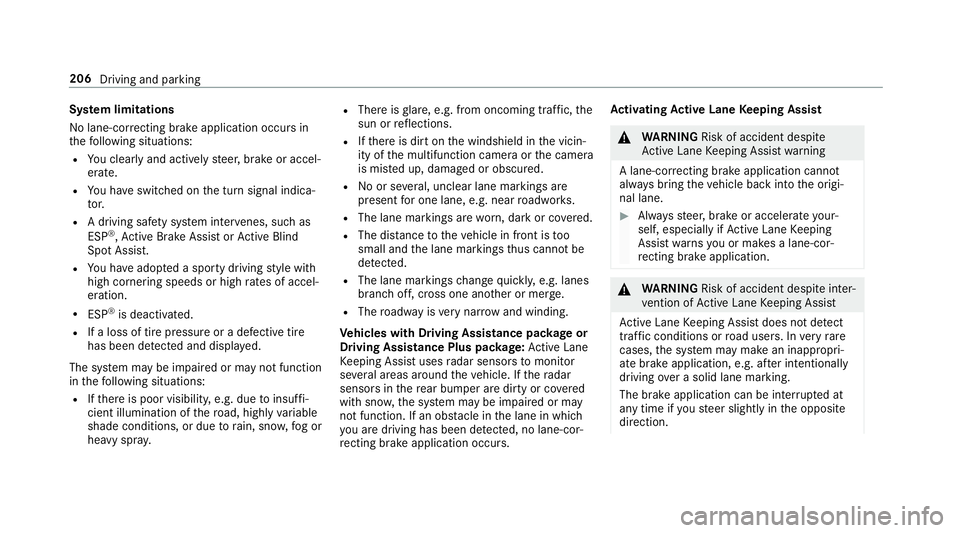
System limitations
No lane-cor recting brake application occurs in
th efo llowing situations:
RYo u clear lyand actively steer, brake or accel‐
erate.
RYo u ha veswitched on the turn signal indica‐
to r.
RA driving safe ty system inter venes, such as
ESP®, Ac tive Brake Assi stor Active Blind
Spot Assi st.
RYo u ha veadop ted a sporty driving style with
high cornering speeds or high rates of accel‐
eration.
RESP®is deactivated.
RIf a loss of tire pressure or a defective tire
has been de tected and displ ayed.
The sy stem may be impaired or may not function
in thefo llowing situations:
RIf th ere is poor visibility, e.g. due toinsuf fi‐
cient illumination of thero ad, highly variable
shade conditions, or due torain, sno w,fog or
heavy spr ay.
RThere is glare, e.g. from oncoming traf fic, the
sun or reflections.
RIf th ere is dirt on the windshield in the vicin‐
ity of the multifunction camera or the camera
is mis ted up, damaged or obscured.
RNo or se veral, unclear lane markings are
present for one lane, e.g. near roadwor ks.
RThe lane markings are worn, dark or co vered.
RThe dis tance totheve hicle in front is too
small and the lane markings thus cannot be
de tected.
RThe lane markings change quickl y,e.g. lanes
branch off, cross one ano ther or mer ge.
RThe roadw ayisvery nar row and winding.
Ve hicles with Driving Assistance pac kage or
Driving Assistance Plus pa ckage: Active Lane
Ke eping Assist uses radar sensors tomonitor
se veral areas around theve hicle. If thera dar
sensors in there ar bumper are dirty or co vered
with snow ,th e sy stem may be impaired or may
not function. If an obs tacle in the lane in which
yo u are driving has been de tected, no lane-cor‐
re cting brake application occurs .Ac
tivating Active Lane Keeping Assist
&
WARNING Risk of accident despite
Ac tive Lane Keeping Assist warning
A lane-cor recting brake application cannot
al wa ys bring theve hicle back into the origi‐
nal lane.
#Alw aysst eer, brake or accelera teyour‐
self, especially if Active Lane Keeping
Assist warnsyo u or makes a lane-cor‐
re cting brake application.
&
WARNING Risk of accident despite inter‐
ve ntion of Active Lane Keeping Assist
Ac tive Lane Keeping Assist does not de tect
traf fic conditions or road users. In very rare
cases, the sy stem may make an inappropri‐
ate brake application, e.g. af ter intentional ly
driving over a solid lane marking.
The brake application can be inter rupte d at
any time if yousteer slightly in the opposite
direction.
206 Driving and parking
Page 209 of 502
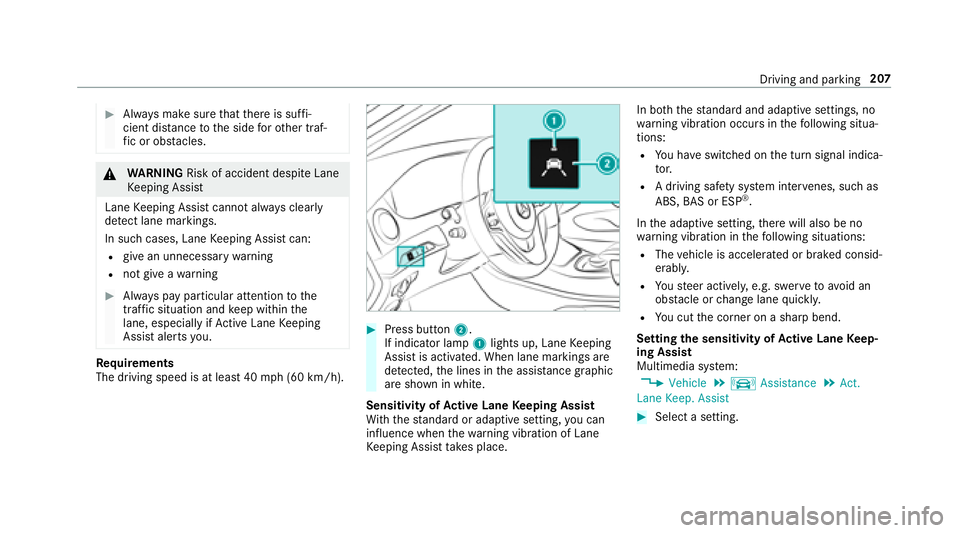
#Always make sure that there is suf fi‐
cient dist ancetothe side forot her traf‐
fi c or obs tacles.
&
WARNING Risk of accident despite Lane
Ke eping Assist
Lane Keeping Assist cannot always clearly
de tect lane markings.
In such cases, Lane Keeping Assist can:
Rgive an unnecessary warning
Rnot give a warning
#Alw ays pay particular attention tothe
traf fic situation and keep within the
lane, especially if Active Lane Keeping
Assist alerts you.
Re quirements
The driving speed is at least 40 mph (60 km/h).
#Press button 2.
If indicator lamp 1lights up, Lane Keeping
Assist is activated. When lane markings are
de tected, the lines in the assis tance graphic
are shown in white.
Sensitivity of Active Lane Keeping Assist
Wi th th est andard or adaptive setting, you can
influence when thewa rning vibration of Lane
Ke eping Assist take s place. In bo
th thest andard and adaptive settings, no
wa rning vibration occurs in thefo llowing situa‐
tions:
RYo u ha veswitched on the turn signal indica‐
to r.
RA driving safe ty system inter venes, such as
ABS, BAS or ESP®.
In the adaptive setting, there will also be no
wa rning vibration in thefo llowing situations:
RThe vehicle is accelerated or braked consid‐
erably.
RYo usteer actively, e.g. swer vetoavo id an
obs tacle or change lane quickl y.
RYou cut the corner on a sharp bend.
Setting the sensitivity of Active Lane Keep‐
ing Assist
Multimedia sy stem:
,Vehicle.k Assistance.Act.
Lane Keep. Assist
#Select a setting.
Driving and parking 207
Page 210 of 502
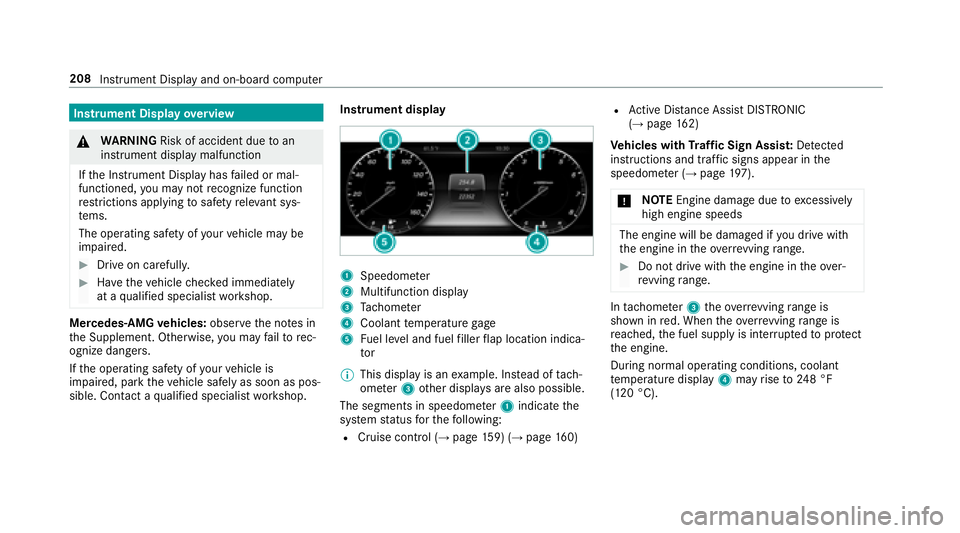
Instrument Displayoverview
&
WARNING Risk of accident due toan
instrument display malfunction
If th e Instrument Display has failed or mal‐
functioned, you may not recognize function
re strictions applying tosaf etyre leva nt sys‐
te ms.
The operating saf etyof your vehicle may be
impaired.
#Drive on carefull y.
#Have theve hicle checked immediately
at a qualified specialist workshop.
Mercedes‑AMG vehicles: observeth e no tes in
th e Supplement. Otherwise, you may failto rec‐
ognize dangers.
If th e operating saf etyof your vehicle is
impaired, park theve hicle safely as soon as pos‐
sible. Contact a qualified specialist workshop. Instrument display
1Speedome
ter
2Multifunction display
3Ta ch ome ter
4Coolant temp erature gage
5Fu el le vel and fuel filler flap location indica‐
to r
% This display is an example. Inst ead oftach ‐
ome ter3 other displa ysare also possible.
The segments in speedome ter1 indica tethe
sy stem status forth efo llowing:
RCruise control (→page 159) (→page 160)
RAc tive Dis tance Assist DISTRONIC
(→pa ge 162)
Ve hicles with Traf fic Sign Assis t:De tected
instructions and traf fic signs appear in the
speedome ter (
→page 197).
* NO
TEEngine damage duetoexc essively
high engine speeds
The engine will be damaged if you drive with
th e engine in theov errevving range.
#Do not drive wi th the engine in theove r‐
re vving range.
In tach ome ter3 theove rrev ving range is
shown in red. When theove rrev ving range is
re ached, the fuel supply is inter rupted toprotect
th e engine.
During normal operating conditions, coolant
te mp erature display 4may rise to248 °F
(120 °C).
208 Instrument Display and on-board computer